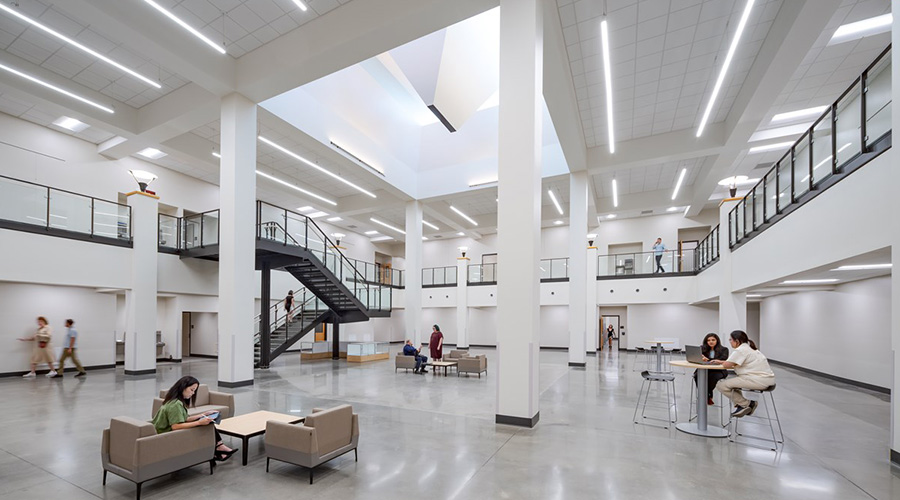Insulation in a New Light
New tax incentives, along with growing needs for energy efficiency, prompt managers to take a closer look at benefits of insulation
The renewed search for enhanced energy efficiency in facilities has covered all of the usual suspects in HVAC systems and elsewhere. Increasingly, managers’ efforts to curtail energy use in the face of rising utility costs have focused more on materials and components that often can go overlooked at such times. Insulation is among the materials that has the potential to help organizations control energy use.
But maintenance and engineering managers also are taking a closer look at insulation for other reasons.
A Range of Benefits
Like many components of buildings, insulation suffers from an “out of sight, out of mind” mentality among many people in facilities.
“I don’t want to say insulation is taken for granted, but insulation is taken for granted, “ says Bob Gardner, technical services director for Knauf Insulation. “It’s the biggest problem we have.“ Among the reasons managers might want to revisit their facilities’ uses of insulation is an array of potential benefits.
Energy efficiency. Energy considerations remain the primary reason managers are rethinking the use of insulation. And the higher energy prices climb, the more questions managers will have about opportunities for savings.
“Facilities’ favored rates from utilities are narrowing,” says Tom Newton with CertainTeed Corp. In some areas of the country, utility rates have increased 50 percent in the last five years. The good news, in Newton’s view, is that many commercial and institutional facilities are ripe for greater energy efficiency.
“They are probably better suited for energy savings than the average homeowner,” he says, because of facilities’ size and relative inefficiency.
In short, properly specified, installed and maintained insulation —whether the product selected is rock wool or fiberglass, duct liner or pipe wrap — protects against unintended heat loss as air is distributed throughout a facility. And as ventilation requirements for facilities have become more strict in recent years, the demands on HVAC systems have grown. As a result, the thermal benefits of proper insulation have become even more important.
“If you use the proper amount of insulation, you can save a tremendous amount of money, and you can downsize your HVAC equipment,” Gardner says.
Managers inevitably will need to provide justification for such projects, but the good news is that for many insulation projects, the payback can be relatively quick. For steam-pipe applications, for example, the payback on the investment can be less than a year.
Indoor air quality. As awareness grows regarding the impact of indoor air quality (IAQ) on occupant health and productivity, manufacturers also are playing up the role of insulation in improving the indoor environment.
”Insulation offers real benefits in terms of preventing IAQ problems, Gardner says. “But it’s not something that’s been a top-of-mind issue.”
Insulation can help managers minimize IAQ problems by preventing moisture formation on HVAC system components. Condensation can form on bare sheet metal ducts wherever the surface temperature reaches the dew point.
The moisture then can remain in place or drip, causing damage, such as wet ceiling tiles, and creating an environment that allows microbial growth. Insulation can help address the problem by reducing moisture formation and eliminating conditions that can lead to bigger problems.
Improving indoor environments can have bottom-line benefits.
“Healthier indoor environments also can help control organizations’ health care costs,” Newton says.
Acoustics. Many areas of facilities at some point suffer from problems caused by noise, and many occupants are getting tired of dealing with the problem.
“People definitely are becoming more aware of the problem,” Gardner says. But managers often overlook the role insulation can play in addressing the issue.
“Managers tend to look only at the thermal benefits of insulation, not the acoustic benefits,” he says. Duct board and duct liners can improve acoustics by reducing the transmission of HVAC noise through the duct system created by air turbulence and the expansion and contraction of steel ducts. Insulation also can reduce the noise transfer between rooms via ductwork.
EPAct Arrives
Managers have yet another incentive to weigh upgrading their facilities’ insulation, as well as other energy-related components. The Energy Policy Act of 2005, became effective on Jan. 1, 2006, and established a new deduction for expenses incurred for energy-efficient commercial. Energy-efficient commercial building property is defined as:
-
property within the scope of ASHRAE Standard 90.1-2001, Energy Standard for Buildings Except Low-Rise Residential Buildings
-
installed as part of interior lighting, HVAC, and hot-water systems, or the building envelope
-
part of a plan designed to reduce annual energy and power costs of these systems by 50 percent or more compared to a reference building that meets the minimum requirements of Standard 90.1-2001.
The deduction is equal to energy-efficient commercial building property expenditures made by the taxpayer and is limited to $1.80 per square foot
The new tax incentives are “definitely drawing attention,” Gardner says. “It’s a step in the right direction.”
Product Decisions
Managers looking for information on insulation that targets their organizations’ needs have a range of products from which to choose. Making the selection process a bit easier is the fact that many insulation products have changed only slightly in recent years.
“We wish we had something new every six months, but we don’t,” Gardner says. “There’s nothing space-age here. But (the minimal change) also means that nobody has come up with anything that has worked better.”
That said, manufacturers have rolled out insulation products with some important changes. Some newer products have higher R values, for example. And one manufacturer has introduced a hard-surface insulation product that promises better durability and acoustics. Its hard surface also means it can be cleaned and doesn’t absorb moisture.
Managers looking for up-to-date information on insulation products obviously can talk with manufacturers, but they also can work with contractors specializing in insulation installations to select the most appropriate products.
“Managers don’t have to be experts,” Newton says, adding that facilities’ need for greater energy efficiency has heightened the competition among contractors. “Contractors will be out there fighting for your business.”
Managers also need to fully understand certification and rating systems for insulation products to ensure the products deliver the promised performance and safety benefits.
Finally, as managers know better than anyone else, no facilities component performs as intended without the proper maintenance, and insulation is no exception. Both Newton and Gardner recommend insulation inspection and maintenance programs that include checks for damaged insulation surfaces, properly sealed seams, and surfaces that are free of debris and dirt. Without such measures, insulation is likely to fall short of the expectations of both managers and their organizations.
Spotlight: NAIMA
Members of the North American Insulation Manufacturers Association (NAIMA) are manufacturers of fiberglass, rock wool and slag wool insulation products. NAIMA promotes energy efficiency and environmental preservation through the use of fiberglass, rock-wool and slag-wool insulation products, while encouraging safe production and use of these products.
NAIMA is the industry for architects and builders; design, process and maintenance engineers; contractors; codes and standards organizations; and government agencies. The association advocates for stronger building and energy codes and standards.
The association maintains research on the health, safety and benefits of glass, rock, and slag fibers, and it disseminates the results to government agencies, the industry, customers, contractors, employees, and the general public. NAIMA also publishes literature on product performance, installation guidelines, energy-saving tips, insulation needs, building code guidance, and general health and safety aspects of insulation.
The association sponsors and develops training initiatives at technical schools, community colleges, engineering schools.
For more information, visit www.naima.org, www.simplyinsulate.org and www.pipeinsulation.org.
|
Related Topics:











